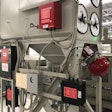
Having the knowledge and proper tools to easily pivot between tasks can keep your grain operation running smoothly. To achieve a lasting bin foundation and tools needed, evaluate your options, recognize the drawbacks and choose equipment best fit for your scenario.
Begin with the basics
Circular concrete pours most often start with a pivot kit, which minimally consists of a metal stake fixed to a weighted base. The stake is affixed to the center of the work area and can be used as a guide to frame out the circular pad.
A pivot kit gives users the ability to attach one end of a concrete screed to the center stake and control the screed from the other end, screeding off concrete in a clockwise motion. Any number of concrete screed options can attach to a pivot kit.
The most popular methods include hand screeding, using an A-frame screed or working with a roller screed, but each come with their own limitations.
Consider the options and limitations
Hand screeding utilizes a long aluminum or heavy wooden board which is extended to the center stake and pulled by hand around the circular form. This can be a strenuous, time consuming task and may result in structural flaws due to a warped board and uneven concrete dispersion. With structural flaws rarely justifying savings, this option leads many to explore the methods implemented by professional contractors, like an A-frame or roller screed. These methods have varying levels of usability, with some more user friendly than others.
A-frame screeds consist of multiple sections and can be more cumbersome than alternatives. Fins and vibratory attachments hang off the back of the main bar to provide a compacted and smooth finish as the screed pulls, vibrates and spreads the concrete. However, this design limits screeding to one direction. A roller screed, on the other hand, consists of a drive head and pipe that spins in the opposite direction it is being pulled to level concrete. Roller screeds can be electric, hydraulic or gas motor powered and are typically lighter and easier to maneuver than an A-frame. However, a gas motor can be a limiting factor as it restricts the direction of the spin, a shortcoming similar to the A-frame's. But what’s wrong with only screeding in one direction?
The downside of unidirectional screeding
Unidirectional screeding is often acceptable for conventional concrete flatwork but less favorable with circular pours. A circular concrete pad can take several hours to pour, and unidirectional screeds are committed to screeding one direction for the duration of the project. For efficiency and minimal wasted movement, the pad is usually poured in continuous sections with, for example, the first being from 12 to 2 o’clock. A farmer screeds that section and then the next is poured from 2 to 4 o’clock, and so on.
This might seem effective, but once the pour is nearing completion and arriving back to the first section, the crew is now pouring and screeding wet concrete next to concrete that has been curing for several hours. This creates a cold joint which can cause a division in the uniformity of the concrete pad, preventing it from curing as one solid, smooth, level foundation. The visual irregularity from a cold joint may leave something to be desired for the concrete pad’s appearance, but it’s also a structural flaw that can result in future costly repairs or possible grain bin failure.
A multidirectional solution
The best method to avoid a cold joint is by pouring each section of concrete and alternating left and right sides of the circle. For example, if a section is poured at the circle’s 12 to 2 o’clock position, the next section could be poured from 2 to 4 o’clock, but the third section should be poured from 10 to 12 o’clock. This alternating pattern ensures every section cures for the shortest amount of time before fresh concrete is poured next to it, leading to a more uniform cure.
This alternating pattern introduces the utility of screeds with a changeable spin direction. For all roller screeds to operate correctly, the screed pipe spins away from the operator. But, the ability of some screeds to change spin direction at the push of a button allows operators to effortlessly screed clockwise or counterclockwise, making these screeds capable of performing the alternating pattern efficiently. This means operators can alternate screeding sections rather than working in a full rotation and risking cold joints and wasted movement.
Multiple manufacturers offer directional changing features on their screeds, but many do not make the switch an easy one. Some screeds require the entire drive head of the screed to be removed from the attached pipe, rotated and reattached to the other side to change the direction. Whereas manufacturers that incorporate intuitive design features, like directional buttons, provide unmatched efficiency that also carries over to maintenance and transport.
Prioritize efficiency
Work can get busy and messy on a farm. For special projects, like circular pours, farmers can’t afford to waste time on inefficient methods and bulky equipment that is a hassle to assemble, use, clean, disassemble and transport.
Some roller screeds are engineered for quick assembly and breakdown, designed with users like farmers in mind who need high-quality — but efficient — solutions. They can be found with adjustable handles that lock into place for compact and lightweight transport. These roller screeds detach from their pipes in seconds and can be carried by a single worker. This compact, thoughtful design also makes for a screed that can be easily cleaned, just requiring a simple wipe down of the drive head, handles and pipe — a perfect scenario for working in rural locations.
A-frame screeds, on the other hand, come in multiple sections that require extensive setup and disassembly. These screeds can easily weigh over 100 pounds with just a few sections — A-frames large enough to extend the radius of a standard grain bin pad can weigh nearly twice that. Connecting sections can also leave dozens of seams and gaps for concrete to seep in, further complicating cleaning and maintenance. This can prove quite disheartening after looking up from a long day of concrete work and realizing the maintenance and cleaning downtime that awaits. The remote bin location can also hinder efficiency depending on the screed employed.
Location limitations
Grain bins are often located in areas that might make equipment access and transportation complicated. But, more importantly, remote locations may limit access to a power supply.
Corded electric roller screeds are a convenient option and provide constant power without needing gas, batteries or a source of hydraulic power. However, limited power supply in remote areas is still an issue and requires a portable generator. Plus, running multiple extension cords to a nearby power source can be a potential hazard.
Hydraulic screeds are another option. They have the power to spin the largest custom pipes to tackle heavy duty applications but depend on extra equipment for hydraulic power, a burdensome requirement on busy farms.
Thankfully, some manufacturers have recognized the demand for a screed that’s not only maneuverable, but also suited for rural applications by offering expanded power options. Battery-powered roller screeds have no cords or hoses and can be easily operated in remote environments without the need for an external power supply. Look for a screed that utilizes common 60-volt lithium-ion batteries like those found in standard battery-powered drills. Some screeds utilizing such batteries can screed up to 2,500 square feet of concrete on one charge, more than enough to screed-off any standard grain bin pad.
The stress-free operation of battery powered roller screeds combined with minimal assembly significantly lowers the learning curve and operational requirements when compared to A-frame screeds. Paired with a manufacturer’s pivot kit, battery-powered roller screeds allow any skill level to take on jobs that could typically fall out of reach.
A farmer is no stranger to recognizing efficient solutions. Tackling a circular pour with equipment already on the farm is possible, but alternative methods can offer time savings and lasting quality that far outweigh the initial investment.
About Curb Roller Mfg.
Curb Roller Mfg. has been the world leader in shaped concrete roller screeds for more than 10 years.

















